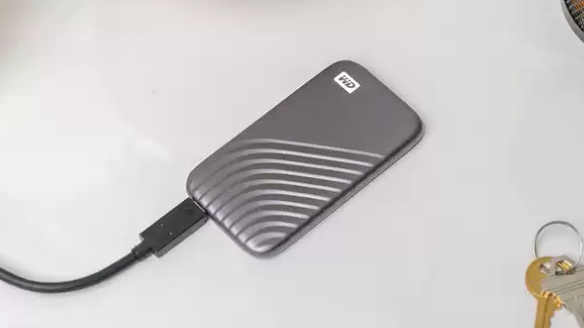I’m old enough to remember buying external HDDs that had the big Boi HDD inside a massive case that required a power cable. Yup, a separate power cable for running that extra disc space. Then they came down in size and ran with the power from USB. They were all slow as balls, but hey, it was still pretty awesome.
Well, nowadays, with portable SSDs, they aren’t much bigger than a credit card, and they fly insanely fast. So I took two of these beasties for a spin to see how they hold up and if it was worth getting one. Bring on the WD My Passport SSD and the SanDisk Extreme Portable SSD.
Size and Style
These two portable SSDs are both made by Western Digital and are similar, so they were the perfect two to run side by side. I expected them to be small when I opened the box, but holy crap! Popping them on a credit card, it was the same height, but the SSDs were slightly longer. When I say these things are small, I mean small. These are perfect to slot into your lappy bag or slip into your pocket.
Best of all, they both look dope as hell. The WD My Passport SSD has a nice brushed metal style with the wave pattern on it, which is sleek. The SanDisk Extreme Portable SSD is about a mm thicker thanks to the rubber coating on it. It’s also equipped with a sturdy loop, so you can lock it into a carabiner on your bag or belt. I mean, I’m not attaching a SSD to my belt, but you do you.
But what if I break it?

The obvious fear with a small device like this knocking about in your bag is that it’s going to break. Well, fortunately, the WD My Passport SSD has been built to withstand up to two-meter drops. I threw the thing around my lounge for what I would describe as an unreasonable amount. I plugged it into my laptop, and it didn’t miss a beat.
Even more impressive is the SanDisk Extreme Portable SSD, which comes equipped with up to three-meter drop protection and IP65 water and dust resistance. I dropped this one down some stairs, and yet again, I couldn’t even tell.
In other words, if you aren’t being daft with your lappy bag, you would have to work hard to break these two.
But is it good to use?

Oooooh, yeah, it is. I have used many portable HDDs over the years, and even transferring files to the disc can take its sweet time. The most annoying thing is watching Windows start with an ambitious plan, then watch the speeds absolutely tank after a minute.
Both of these SSDs come with sequential read speeds of up to 1050 MB/s and sequential write speeds of 1000 MB/s. What does that mean? They are bloody fast. I jammed both into a PC via the included USB-C to USB-C cable and using the USB-C to USB-A adapters. I was consistently transferring files ranging 800 MB to 2 GB to and from the drives in seconds. It was slightly faster via USB-C, to USB-C but not much.
Best of all, the Windows estimated speed stayed consistent for those seconds.

Both of the portable SSD’s come equipped with a USB-C port, a super short USB=C to USB-C cable, and a USB-C to USB-A adapter. Initially I was nervous about the length of the cable, but of course a portable device is only so portable when you have a super long cable to fill your bag with. So it makes sense, and if you want a longer cable, there are plenty of longer USB-C to USB-C cables you can pick up cheap enough.
So should you get one, and which one?

These are two damn great portable SSDs. Seriously, if you need one that is portable, then you will be damn happy with either of these. They are both damn sturdy and damn tidy. If you were buying one to be thrown around in a school or work bag, I’d be leaning towards the SanDisk Extreme Portable SSD, but if you prefer the style of the My Passport, you’ll be happy. If anything, you can grab whichever you see at the best price, as they both vary between $200 and $300 for 1TB.


1 Comment
Pingback: Yeah Nah Gaming - Valentine's Day Gift Guide - Yeah Nah Gaming